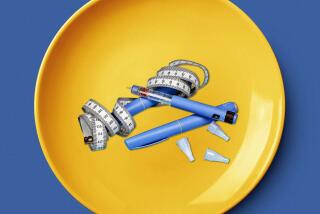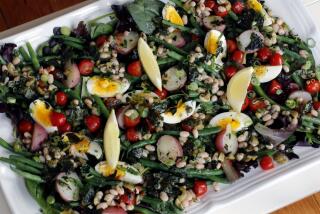The Hows and Whats of 7 Diets
- Share via
Pritikin
What: A low-fat diet developed by researcher Nathan Pritikin to fight and prevent cardiovascular disease. It later attracted other health-minded dieters because they could fill up on bulky foods and still lose weight while lowering cholesterol levels.
How: Focus is on low-fat foods and complex carbohydrates, grains, modest amounts of nonfat dairy products, lean meat, poultry and fish, high-fiber fruits and vegetables. It encourages five to six small meals a day, plus regular exercise and stress reduction.
Percentage of calories per day: Carbohydrates, 70% to 80%; protein, 10% to 20% or less; fat, 10% or less.
Approximate daily caloric intake: 1,200 to 1,400 for women; 1,300 to 1,600 for men. Counting calories is not stressed; smart food choices are.
Exercise: Three to five aerobic workouts per week, 25 to 45 minutes per session (walk, jog, swim, row, cycle, dance), plus resistance training, two to three times a week, from 10 to 30 minutes.
Pros: Encourages lifestyle changes. Appeals to lovers of complex carbohydrates and exercise.
Cons: Some dieters feel it’s too spartan; the food lacks the rich mouth-feel that fat provides. Some medical authorities question cutting fat to 10%. Others say the diet is unrealistic.
*
The Zone
What: A low-carbohydrate, high-protein eating program developed by biochemist Barry Sears. It’s used for weight loss and achieving optimal energy. The recently published “Mastering the Zone” (HarperCollins, 1997; $25) contains more interesting recipes than the first book and is easier to read.
How: Weight loss comes by calorie restriction and exercise. Foods stressed are lean meat, chicken, fish, non-starchy vegetables and certain fruits. Rice, potatoes, grains, breads and other starches are used in moderation. According to Sears, people need to select food combinations that balance fat and protein because the body’s hormonal balance is influenced by the foods we eat. To maximize health, individuals need to find their own “zone.” Dieters select food combinations (called blocks) to create Zone-favorable meals. No meal should exceed 500 calories.
Percentage of calories per day: Carbohydrates, 40%; protein, 30%; fat, 30%.
Approximate daily caloric intake: 1,000 for women; 1,300 for men.
Exercise: About 30 minutes of daily aerobic exercise, such as walking, and five minutes of weight-bearing exercise, such as using dumbbells.
Pros: Sears’ message is one of balance and moderation, portion control, frequent meals and regular exercise. His contribution, say some nutritionists, is getting fat-phobic people to add moderate amounts of protein and fat to their diets. Many athletes and testimonials from celebrities have popularized The Zone. Women are said to like it because it reduces bloating by reducing carbohydrates that hold more water than protein.
Cons: Medical professionals criticize Sears for his lack of documented research and take issue with his ideas on hormonal imbalance. People who love carbohydrates find the diet hard to live with for a long period of time. Some dieters complain that buying so much protein increases their food costs.
*
Weight Watchers
What: Low-fat diet program by nationally recognized weight-loss group. It follows basic dietary guidelines from major health organizations and U.S. Department of Agriculture.
How: Menus emphasize low-fat and high-fiber foods. Foods are broken down into food groups and servings, not into calories. Participants attend weekly meetings at which they are weighed, listen to a lecture and discuss problems and diet-related matters. Group support provides motivation. Membership is by weekly fee.
Percentage of calories per day: Carbohydrates, 50% to 60%; protein, 20%; fat, 30% or less.
Daily caloric intake: Depends on individual’s weight, but ranges between 1,200 and 1,745 calories for both men and women.
Exercise: 20 to 30 minutes of aerobic exercise daily; walking is emphasized, plus a combination of toning and stretching exercises.
Pros: It promotes safe, steady weight loss and reinforces lifestyle changes. A variety of eating plans promotes flexibility. Group support appeals to many who failed previous diets. Weekly weigh-ins help keep dieters on track. Considered medically sound by professionals.
Cons: Suffers from a conservative image and fails to promise miracles. Enrollment fee adds to cost. Initial registration fee is $17 to 19; weekly meeting charge is $11 to $13. Exact price varies depending on area of california and US in general. Some complain that the meal plans aren’t interesting enough for long-term eating.
*
Jenny Craig Weight Loss Systems
What: Weight-loss program promotes low-fat diet with a variety of menu programs. Created in 1983 and based in La Jolla, it has about 130,000 members.
How: Dieters follow planned menus and eat only Craig’s brand of proportioned shelf and frozen packaged entrees and snacks during dieting phase. When desired loss is achieved, clients make transition to self-planned menus. Program stresses keeping logs, attending meetings, weigh-ins with trained consultants and lifestyle classes.
Percentage of calories per day: Carbohydrates, 60%; protein, 20%; fat, 20%.
Daily caloric intake: 1,000 to 2,000, depending on height, weight and activity level.
Exercise: Cardiovascular activities three to five times a week for 20 to 60 minutes, plus strength training.
Pros: It works as long as you follow the rules.
Cons: Some dieters criticize the taste of Craig’s food and say it restricts the dieter’s social life. Enrollment fee is costly. The deluxe plan ($349 per year excluding meals) includes unlimited maintenance, and if members remain within 5 pounds of their desired weight after one year, half of the enrollment fee will be refunded. Standard one-year plan ($99) includes guidebook, classes and consultations and excludes meals.
*
Dr. Atkins
What: A high-protein, low-carbohydrate diet created by New York-based physician Robert Atkins and printed in his latest book, “Dr. Atkins New Diet Revolution” (Avon Books, 1997; $6.50). His earlier diet book, “Dr. Atkins Diet Revolution,” was published in 1972. The new book comes with a companion recipe book written by his Czech-born wife, a former opera singer. The new book gives dieters more flexibility and offers a wider choice of foods and recipes.
How: Foods include meat, fish, fowl, eggs, butter, cheese and fats. As weight loss is achieved, the dieter adds unrefined carbohydrates, mainly non-starchy vegetables and some fruits: potatoes, sweet potatoes, broccoli, soybeans, tomatoes, corn, popcorn, red wine, berries, melons, peaches and plums. (Refined carbohydrates such as white sugar and flour are to be avoided.) Atkins claims that when carbohydrates are severely limited, the body burns its own fat; high-protein foods, most of which contain fat, help stave off hunger.
Percentage of calories per day: During 14-day induction diet: carbohydrates, 5%; protein, 34%; fat, 60%. On the maintenance diet: carbohydrates, 12%; protein, 35%; fat, 54%.
Daily caloric intake: Approximately 1,700 calories for women; up to 2,300 calories for men.
Exercise: Not necessary, but valuable for toning and socialization. Recommends stretching, resistance and recreational sports.
Pros: Diet is a hit with people who love fatty foods, including pate and sausage, eggs and butter.
Cons: Critics say it is nutritionally unbalanced; low in fiber-rich foods. Very restrictive for dieters who enjoy carbohydrates.
*
New Beverly Hills Diet
What: Update of fad diet first published by Judy Mazel in book form in 1981. Mazel’s latest book, “New Beverly Hills Diet” (Health Communications Inc., 1996; $12.95), allows more flexibility than the first. It’s a 35-day plan to lose weight through high consumption of low-calorie produce and food combining (eating certain food groups to facilitate digestion). The food combining angle is not new; versions were current in the ‘20s.
How: Certain foods must be eaten at certain times. Eat protein with protein; carbohydrates with carbohydrates; fat with either protein or carbohydrates. Fruit must be eaten alone. Mazel believes certain enzymatic fruits (pineapple, papaya, watermelon, strawberries, kiwis) plus food combining will facilitate weight loss.
Percentage of calories per day: Carbohydrates, 55% to 60%; protein, 20% to 25%; fat, 20%.
Daily caloric intake: From 1,500 calories. Dieters balance eating over a week, not daily. Daily weigh-in is encouraged.
The updated version allows more mixing of food groups and occasional splurges.
Exercise: Optional.
Pros: Diet works for many because it is rigid and empowers dieters with short-term success.
Cons: There is no mainstream scientific evidence that the body processes particular combinations of foods differently than it processes random combinations. Low in nutrients and protein. Can cause diarrhea and bloating. Promotes loss of protein tissue.
*
The New Cabbage Soup Diet
What: Low-calorie soup diet popularized by Margaret Danbrot. Creator is unknown. Most recently described in “The New Cabbage Soup Diet” by Margaret Danbrot (St. Martin’s Paperbacks, 1997; $4.99).
How: Dieters eat a homemade cabbage soup stocked with low-calorie vegetables. They’re encouraged to drink lots of water. More starches are added in small quantities. Dieters are warned not to follow the diet longer than seven days.
Daily caloric intake: Between 700 and 1,000 calories.
Exercise: Not recommended for the duration because of the low intake of calories.
Pros: Dieters lose weight by calorie restriction. Feeling of fullness comes with intake of bulky vegetables. Dieters lose water weight.
Cons: Critics call it a typical fad diet that’s nutritionally unbalanced. Can cause gas, nausea and lightheadedness after a few days. Boring, spartan regimen. Does not promote lifestyle changes or good eating habits.


